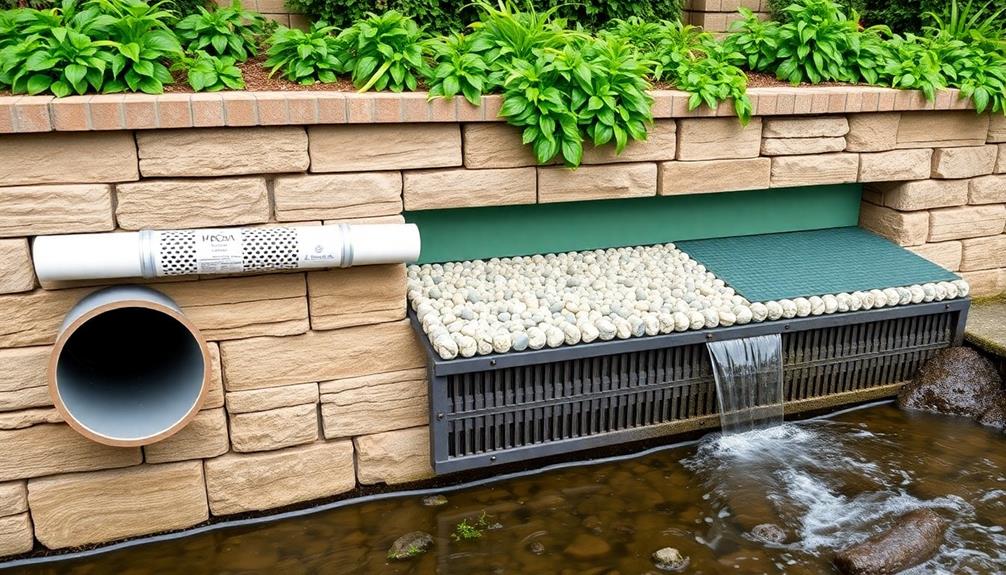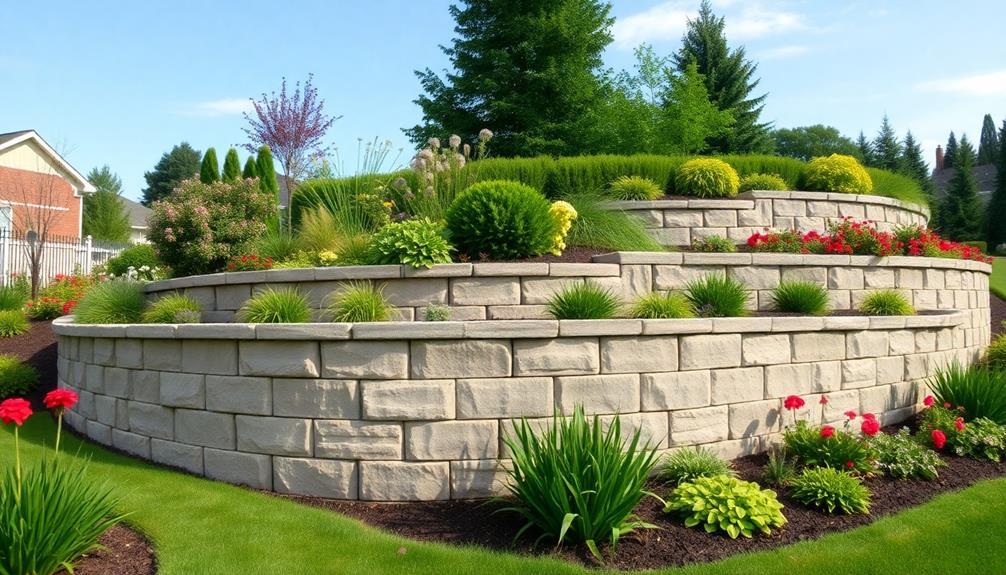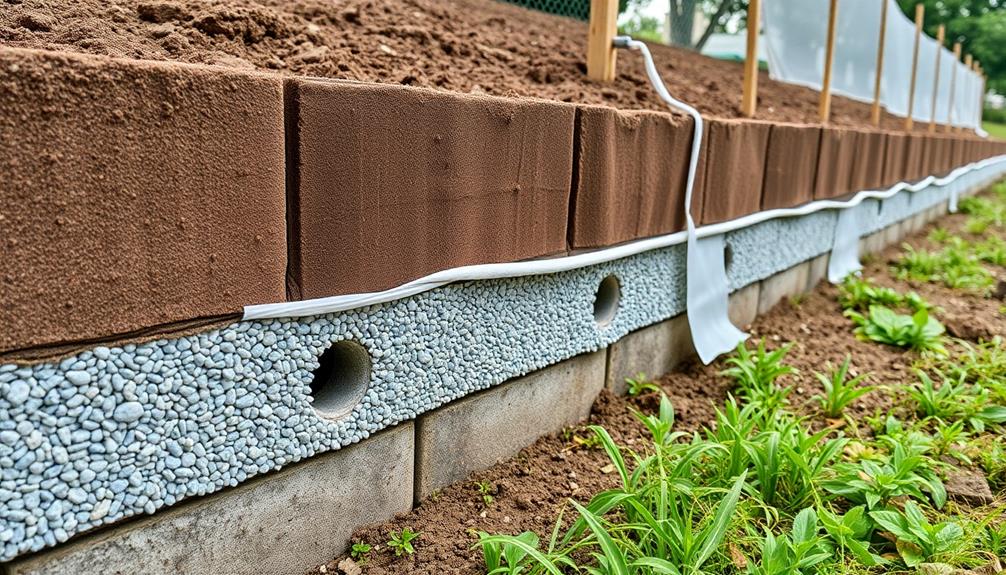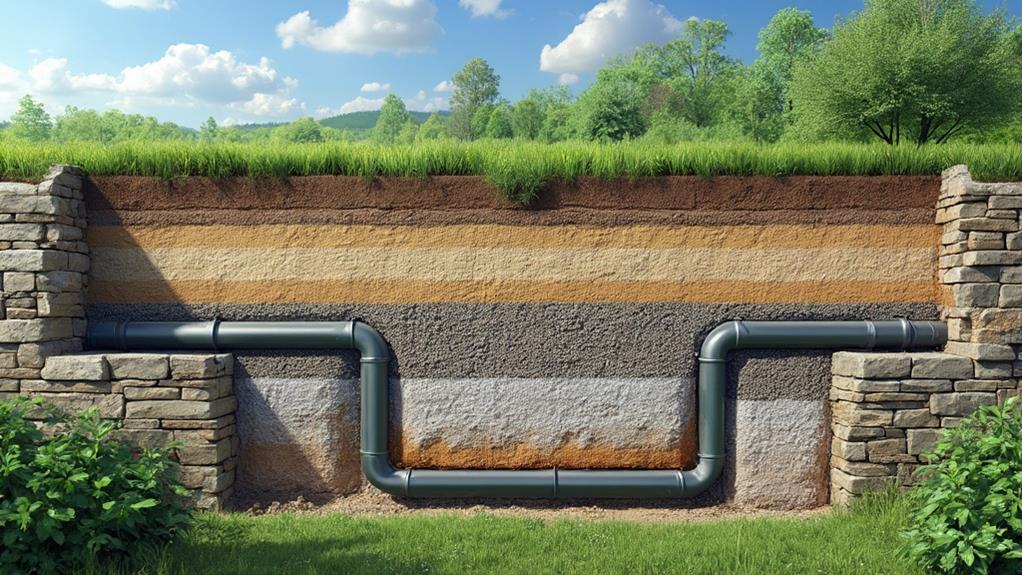Retaining wall drainage solutions are essential for preventing structural damage and extending a wall's lifespan. Key techniques include installing weep holes to alleviate hydrostatic pressure, integrating drainage pipes like French drains to divert water away, and using geotextile fabrics to avert soil clogging. A gravel backfill is crucial for promoting seepage towards the drainage system, while adhering to best practices in installation guarantees drainage layers are correctly positioned and slopes adequately graded. These approaches collectively enhance wall stability, prevent soil erosion, and maintain the surrounding ecosystem health. Exploring these solutions further reveals their intricate mechanisms and benefits.
Table of Contents
ToggleWalls Contractor Highlights
- Effective drainage solutions prevent water accumulation and hydrostatic pressure on retaining walls.
- Retaining wall drainage enhances structural stability and extends the wall's lifespan.
- Key techniques include weep holes, drainage pipes, geotextile fabric, and gravel backfill integration.
- Proper grading and drainage system installation prevent soil erosion and ensure functionality.
- Drainage systems contribute to community safety and confidence in infrastructure resilience.
Overview of Drainage Solutions

In addressing the essential components of retaining wall drainage solutions, it is vital to familiarize oneself with the key techniques that effectively manage water flow and prevent structural damage. For instance, boulder retaining walls require careful installation to guarantee proper drainage and prevent erosion. Material choices, such as the use of gravel, geotextiles, and drainage pipes, play a significant role in the success of these systems, ensuring longevity and effectiveness.
Furthermore, adherence to best practices during installation is of the utmost importance for optimizing functionality, necessitating a careful consideration of gradients, permeable layers, and proper outlet placement.
Key Drainage Techniques
How effectively can a retaining wall function without proper drainage? Without a doubt, drainage is pivotal to the structural integrity and longevity of any retaining wall, acting as a safeguard against the erosive forces of water accumulation. Key drainage techniques ensure that water does not build up behind the wall, which can exert undue pressure leading to failure.
One such technique is the installation of weep holes—strategically placed openings at the base of the wall that enable trapped water to escape, thereby reducing hydrostatic pressure.
In addition to weep holes, the integration of a drainage pipe, commonly referred to as a "French drain," is essential. This involves a perforated pipe wrapped in a water-permeable fabric, buried in gravel behind the wall. The design allows water to be efficiently collected and diverted away from the structure. Additionally, a geotextile filter fabric can be employed to prevent soil from clogging the drainage system. Finally, utilizing gravel backfill enhances drainage capability as it encourages water seepage towards the drainage assembly. These methods not only preserve the wall's structural soundness but also foster a sense of security, knowing that the underlying drainage issues are addressed thoroughly.
Material Choices Explained
For ideal drainage in retaining walls, selecting the right materials is essential. These materials contribute to the structural integrity and efficiency of the drainage system, guaranteeing water is effectively redirected away to prevent erosion and wall failure. The choice of materials should reflect their compatibility with both the retaining wall's function and the specific environmental conditions they must endure. A thoughtful selection can enhance safety and performance, creating a sense of stability and reliability for your project.
Consider the following essential materials:
- Gravel Backfill: This permeable medium allows water to seep through rather than collecting behind the wall, thereby reducing hydrostatic pressure. Properly graded and compacted gravel confirms efficient drainage and supports structural stability.
- Drainage Pipes: Also known as perforated or weep pipes, these facilitate water movement away from the wall's base, preventing accumulation. Strategically placed, they continuously manage water flow in different weather conditions.
- Geotextiles: Used as a filtration layer between soil and backfill materials, geotextiles prevent soil migration while allowing water to pass, maintaining drainage efficiency. Their durable fabric strengthens soil structure and prolongs the lifespan of the retaining wall system.
Choosing these materials not only safeguards construction but also fortifies the collective effort towards sustainable, long-lasting development in your community.
Installation Best Practices
With the right materials in place, the focus shifts toward the installation best practices that guarantee effective drainage solutions for retaining walls. Critically, the process begins with establishing a secure foundation. The foundation should be compacted to avoid settlement that may disrupt the structure and drainage.
Depending on soil type and site conditions, a drainage layer—typically crushed stone or gravel—needs to be meticulously laid behind the wall, providing a path for water to escape, preventing hydrostatic pressure build-up.
Efficient installation involves ensuring proper slope and grading. The retained soil should slope away from the wall, directing surface runoff in a controlled manner. Integrating weep holes or drainage pipes is indispensable, as they enable water passage through the wall, preventing water from accumulating and compromising stability.
Equally important is understanding local environmental factors like rainfall intensity and soil permeability, which guide the installation's design. Adhering to best practices fosters not only the structural integrity of retaining walls but also a sense of belonging among those who seek shared expertise and professional assurance. Pursuing precision in installation translates into long-term community trust in the resilience and efficiency of these fundamental structures.
Benefits

Implementing effective drainage solutions for retaining walls is vital as it prevents water accumulation, which can drastically enhance the stability of the structure.
Boulder retaining walls, with their natural stone allure and unique boulder formations, are known for their long-lasting and cost-effective solution. By mitigating the risks of erosion, these systems not only protect the integrity of the wall but also contribute to extending its longevity.
Consequently, these benefits underscore the importance of extensive drainage strategies in maintaining the structural health and resilience of retaining walls.
Prevents Water Accumulation
Proper drainage solutions in retaining walls are essential, as they substantially prevent water accumulation behind the structure. This element is fundamental not only for maintaining the aesthetic value of landscapes but also for preserving the structural integrity of the walls. Accumulated water can exert undue pressure on retaining walls, leading to potential damage or failure. To guarantee the satisfaction of diligent homeowners and engineers, efficient drainage systems are indispensable.
Implementing proper drainage brings about the following benefits:
- Prevention of Soil Erosion: By controlling water flow, the risk of losing topsoil is minimized, preserving the beauty and uniformity of garden landscapes or embankments.
- Reduction in Hydrostatic Pressure: Effective drainage alleviates pressure on the wall, helping to avert cracks and structural fatigue, which could compromise the safety and longevity of the construction.
- Promotion of Plant Health: Properly directed drainage supports a balanced ecosystem in which plant roots thrive, fostering a vibrant and stable environment that offers a sense of harmony.
These measures collectively ensure that retaining walls remain robust, complementing the community's desire for lasting, reliable infrastructure. By prioritizing drainage solutions, we affirm our commitment to shared safety and environmental well-being, fostering a sense of belonging within our spaces.
Enhances Wall Stability
The backbone of any well-engineered retaining wall is its stability, substantially bolstered by efficient drainage systems. These systems play a critical role in maintaining structural integrity by effectively channeling water away from the wall, thereby mitigating hydrostatic pressure that can lead to destabilization. Without proper drainage, water accumulation against the backfill can create significant pressure, eventually pushing the wall outward or even leading to catastrophic failure.
Thoroughly designed drainage solutions involve components such as perforated pipes, gravel backfills, and drainage mats, which work in tandem to guarantee water does not accumulate but is instead efficiently redirected. By minimizing water retention, these drainage solutions not only enhance wall stability but also prolong the lifespan of the structure, guaranteeing it withstands diverse environmental conditions.
Furthermore, reinforcing the stability of retaining walls through drainage systems fosters confidence in both the builders and community members who rely on them. The collaboration between precise engineering and community needs underscores a commitment to safety and durability. In this way, drainage systems do more than support structures—they cultivate a shared sense of security and dependability, fostering a collective assurance in the built environment we entrust to protect our spaces.
Reduces Erosion Risks
When properly integrated into retaining wall designs, efficient drainage solutions markedly reduce erosion risks, an essential benefit that extends the longevity and attractiveness of the wall and surrounding landscape. Addressing erosion is not merely about preserving aesthetics but also about safeguarding investments and fostering a harmonious relationship with the environment.
Proper drainage systems prevent water accumulation, which can lead to soil instability and subsequent wall failure. These systems function by redirecting water away from saturation-prone areas, ensuring that the soil remains compact and cooperative.
Implementing reliable drainage solutions to combat erosion instills a sense of security among property owners, knowing that their landscapes are resilient against natural adversities.
Peace of Mind: Trust in the knowledge that strategic water management insulates landscapes from the relentless forces of erosion.
Community Aesthetics: Well-maintained structures contribute to a cohesive neighborhood appearance, reinforcing civic pride.
Environmental Responsibility: Effective drainage reflects a commitment to eco-friendly practices, harmonizing built environments with nature.
Extends Structure Longevity
A retaining wall's lifespan is considerably extended through the integration of effective drainage solutions. These systems are instrumental in mitigating the damaging effects of water accumulation, which is a primary cause of wall deterioration. By efficiently channeling water away from the structure, the risk of hydrostatic pressure, which can compromise wall integrity, is drastically reduced. This proactive management of water guarantees the continued stability and strength of the retaining wall, fostering a sense of security and reliability for those who rely on these structures.
Incorporating drainage solutions into a retaining wall design is not merely a preventative measure but an investment in the structure's future. The inclusion of elements such as drainage pipes, gravel backfill, and weep holes can collectively combat the adversities posed by water, thus prolonging the wall's functionality and reducing the need for costly repairs or replacements. These systems support the wall's ability to withstand environmental challenges, providing a sustainable foundation that speaks to the craft and foresight of its builders. By extending a retaining wall's lifespan, such drainage solutions contribute to a community's aesthetic and structural continuity, affirming the shared values of safety and longevity.
Installation Tips and Techniques

In guaranteeing the effective installation of retaining wall drainage systems, selecting the appropriate drainage materials is paramount, as it not only facilitates optimal water flow but also aids in mitigating soil erosion which can compromise structural integrity. Proper materials aid in maintaining functionality and prolonging the lifespan of the wall. To offer a clear understanding, the table below outlines key considerations in the installation process:
| Consideration | Importance | Description |
|---|---|---|
| Drainage Materials | Guarantees durability and effectiveness | Use materials like gravel and perforated pipes for longevity |
| Adequate Water Flow | Prevents hydrostatic pressure | Design slopes to channel water away effectively |
| Soil Erosion Prevention | Maintains structural integrity | Incorporate geotextiles to stabilize surrounding soil |
Choosing Proper Drainage Materials
How do you guarantee the longevity and stability of a retaining wall? Selecting the appropriate drainage materials is indispensable. Superior materials ensure proper moisture management, thereby averting potential structural failings.
This consideration speaks to the shared understanding among homeowners and builders that durability and safety are paramount. Detailed attention to the materials chosen can evoke trust and confidence in the quality of the construction.
To enhance the structural integrity of retaining walls, consider these essential materials:
- Gravel and Crushed Stone: These provide excellent drainage paths, preventing water accumulation which can lead to hydrostatic pressure build-up. The choice of precisely graded material facilitates ideal moisture evacuation.
- Geotextile Fabric: This material assists in filtering soil particles while allowing water passage, protecting the structural base from erosion and ensuring stability over time. It reflects a practical commitment to sustainable building practices.
- Perforated Drainage Pipes: Strategically placed at the base, these pipes gather excess water, promoting safe and efficient drainage away from the wall. This component is pivotal in curbing water damage and maintaining the wall's intended strength and appearance.
With these materials, you are better equipped to create a retaining wall that is both reliable and enduring, fostering a sense of belonging through secure and sustainable structures.
Ensuring Adequate Water Flow
Guaranteeing adequate water flow is essential to prevent issues such as erosion and hydrostatic pressure build-up that can compromise a retaining wall's stability. Proper installation techniques play a pivotal role in maintaining this flow. The strategic placement of drainage pipes, typically at the base level of the retaining wall, facilitates the seamless evacuation of water away from the structure. Utilizing perforated pipes in this context, enveloped in gravel, guarantees that water is efficiently directed away from the wall while minimizing the risk of obstruction from soil particles.
When installing retaining wall systems, integrating weep holes or conduits at regular intervals along the wall serves as an additional precaution, enabling water to exit the wall structure effectively. The careful grading of the backfill material, sloping it away from the wall, aids gravity in directing water flow naturally, reducing stagnation risks. Employing a filter fabric barrier is another effective measure; it acts as a shield to prevent soil from clogging drainage elements while still permitting the unimpeded flow of water.
Incorporating these techniques fosters a sense of community among professionals who collectively value the long-term integrity and safety of their construction endeavors, laying the groundwork for sustainable and resilient retention systems.
Preventing Soil Erosion
Addressing soil erosion is a vital aspect of maintaining the structural integrity of retaining walls. Preventing soil erosion not only upholds the wall's durability but also enhances the aesthetics of the landscaping by promoting stability and cohesion. Recognizing the significance of soil stability ensures that homeowners and communities feel confident in their investment.
Installation of Geotextiles: Incorporating geotextile fabrics as a protective layer offers a solution to stabilize the soil. It helps separate the soil from drainage materials, preventing erosion while allowing water to permeate.
Proper Grading: Ensuring the terrain is correctly graded directs water away from the retaining wall, minimizing the risk of erosion. Proper grading plays an essential role in water management and sustainability, fostering a safe and sound environment for all.
Drainage System Integration: Incorporating drain pipes or other drainage systems behind the wall reduces water pressure that can exacerbate erosion. An effective system not only protects but bestows a sense of security within a community.
Walls Contractor FAQ
What Are the Potential Consequences of Poor Drainage in Retaining Walls?
Inadequate drainage in retaining walls can lead to hydrostatic pressure buildup, causing structural failure, costly repairs, and safety hazards. Addressing drainage issues fosters a sense of community responsibility, ensuring long-term stability and protection for all stakeholders.
How Do Climate and Weather Conditions Affect Retaining Wall Drainage Systems?
Climate and weather conditions profoundly impact retaining wall drainage systems, with heavy rainfall, snowmelt, and freeze-thaw cycles potentially overwhelming drainage capabilities. Ensuring proper design and maintenance can foster stability and community safety, reinforcing a sense of collective security.
What Is the Average Lifespan of Different Types of Drainage Solutions?
The average lifespan of drainage solutions varies considerably. While perforated pipe systems typically last 20-30 years, weep holes might endure a similar range. Advanced systems incorporating modern materials can extend longevity, requiring less frequent maintenance, fostering lasting community infrastructure.
How Does Soil Type Impact the Choice of Drainage Solutions for Retaining Walls?
Selecting appropriate drainage solutions for retaining walls is influenced enormously by soil type. Permeable soils, like sand, facilitate natural drainage; whereas, clay or silt require engineered solutions to prevent water buildup and subsequent structural challenges.
Are There Eco-Friendly Options for Retaining Wall Drainage Systems?
Eco-friendly drainage solutions for retaining walls include permeable systems like gravel beds, green roofs, and vegetated swales. These options not only manage water efficiently but also harmonize with natural surroundings, fostering community connection and environmental stewardship.







